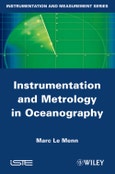Through research, physical oceanography aims to solve the numerous problems stated by thermal, optical and dynamical properties of the oceans. Instrumentation and Metrology in Physical Oceanography describes the means used in oceanography to determine physical properties of the oceans by medium of in situ measurements. This book explores the theoretical functioning of sensors and instruments, as well as different practical aspects of using these tools. The content of this book appeals directly to technicians or engineers wishing to enhance their knowledge of instrumentation and application to environment surveillance.
Instrumentation and Metrology in Physical Oceanography details the functioning of sensors and instruments used to assess the following parameters in oceanography: temperature, conductivity, pressure, sound velocity, current in magnitude and direction, time and position with GPS, height of water and tide, waves, optical and chemical properties (turbidity), dissolved gas (O2, CO2), pH, nutrients and other dissolved elements. Furthermore, this book also elaborates on the different means used to obtain measurements at sea (boats, drifting floats, moorings, undersea platforms, gliders…) and techniques currently being developed.
Table of Contents
Preface ix
Chapter 1. What We Measure and What We Process 1
1.1. The quantities we want to know 1
1.1.1. Velocity and density 2
1.1.2. Pressure and depth 6
1.1.3. Speed and movement 8
1.1.4. Time and space 9
1.2. Linking of essential quantities in oceanography 10
1.2.1. Temperature11
1.2.2. Pressure 20
1.2.3. Conductivity and salinity 22
1.2.4. Velocity 33
1.2.5. Time 38
1.3. Calculation of density 42
1.3.1. Density and EOS-80 42
1.3.2. Laboratory densitometers 45
1.3.3. Density and absolute salinity 46
1.4. Bibliography 48
1.4.1. Quantities that we want to know 48
1.4.2. Linking of essential quantities in oceanography 49
Chapter 2. Measurement Systems in Practice 55
2.1. Determining temperature 55
2.1.1. Principal instruments 56
2.1.2. Sensor technologies 63
2.1.3. Thermal transfers 78
2.1.4. Response time of temperature sensors 83
vi Instrumentation and Metrology in Oceanography
2.1.5. Viscous heating of temperature sensors 88
2.2. Determining conductivity 89
2.2.1. Principle instruments used 89
2.2.2. Sensors’ technologies 90
2.2.3. Response time of conductivity sensors 102
2.2.4. Aligning the response times of temperature and conductivity sensors and correcting thermal inertia 105
2.2.5. Biofouling and protection of instruments 108
2.3. Determining pressure 111
2.3.1. Piezoresistive pressure sensors 111
2.3.2. Piezoelectric pressure sensors 113
2.3.3. Errors in pressure sensor measurements 115
2.4. Determining velocity 116
2.4.1. Principles of measurement 116
2.4.2. Instruments used at sea 123
2.5. Determining current 125
2.5.1. Rotor current meters 125
2.5.2. Doppler effect current meters 129
2.5.3. Electromagnetic current meters 138
2.5.4. Doppler effect profilers 140
2.5.5. Directional referencing of current measurements 151
2.5.6. Calibration of Doppler effect current meters 161
2.6. Determining time or measuring frequency 163
2.6.1. The connection of clocks 164
2.6.2. Time bases of instruments 166
2.7. Determining position and movement 171
2.7.1. The Argos system 171
2.7.2. The global positioning system 178
2.8. Determining the height of water 190
2.8.1. Tide gauges 191
2.8.2. Tide gauges with pressure sensors 199
2.8.3. Keying and uniting of tide gauges 202
2.9. Determining waves and swell characteristics 203
2.9.1. Factors relating to the origins and modeling of swell 203
2.9.2. Instruments used to measure the state of the sea 207
2.10. Determining the turbidity or sea water’s optical properties 220
2.10.1. Theoretical notions of the optical properties of sea water 221
2.10.2. Measurement of apparent optical properties 226
2.10.3. Transmissiometers and measurements of absorption 228
2.10.4. Nephelometers and turbidity sensors 232
2.10.5. Fluorimeters 236
2.11. Determining various physicochemical properties 245
2.11.1. Notions of the chemical parameters of sea water 245
Table of Contents vii
2.11.2. In situ measurement of dissolved oxygen 254
2.11.3. In situ measurement of dissolved carbon 264
2.11.4. In situ measurement of some other components 269
2.12. Bibliography and further reading 277
2.12.1. Measuring temperature 277
2.12.2. Measuring conductivity 279
2.12.3. Measuring pressure 281
2.12.4. Measuring velocity 281
2.12.5. Measuring current 281
2.12.6. Measuring time and frequencies 283
2.12.7. Measuring distance 284
2.12.8. Measuring sea level 285
2.12.9. Measuring state of sea 285
2.12.10. Measuring turbidity and optical properties of sea water 288
2.12.11. Measuring chemical parameters 289
Chapter 3. Measurements at Sea 295
3.1. Oceanographic vessels 295
3.1.1. Ways of launching instruments into the water 296
3.1.2. Ways of positioning and probing 298
3.1.3. Ways to transmit data 303
3.1.4. Ways to make oceanographic measurements by boat 306
3.2. Moorings 309
3.2.1. Constraints of mooring implementation 309
3.2.2. Generalities on the implementation of moorings 310
3.2.3. Deployment and recovery of moorings 325
3.3. Drifters 326
3.3.1. History and operating principles 326
3.3.2. The concept and evolution of the Argo program 328
3.3.3. Principles for positioning by acoustic sources 332
3.3.4. Design and ballasting of drifters 336
3.4. Instrumented buoys and underwater platforms 342
3.4.1. Instrumented buoys 342
3.4.2. Underwater platforms 344
3.5. Bibliography 347
3.5.1. Oceanographic vessels 347
3.5.2. Moorings and anchored floats 348
3.5.3. Drifting floats 349
3.5.4. Buoys and instrumented platforms 351
Chapter 4. Evolutions and other Measurement Concepts 353
4.1. Other processes for measuring salinity and density 353
viii Instrumentation and Metrology in Oceanography
4.1.1. Relationship between density and refractive index 354
4.1.2. Measurement instruments of the refractive index 357
4.2. Acoustic tomography of oceans and acoustic measurements 362
4.2.1. General principles 362
4.2.2. The instrumentation used 365
4.3. The unmanned underwater vehicle: a new means for ocean exploration 367
4.3.1. Energetic autonomy 369
4.3.2.ROV and AUV displacement and positioning 371
4.3.3. Autonomy in decision-making and communication 373
4.3.4. Gliders 374
4.4. Bibliography 377
4.4.1. Other processes for measuring salinity and density 377
4.4.2. Acoustic tomography of oceans and acoustic measurements 378
4.4.3. The UUV: new means for ocean exploration 379
Acronyms and Abbreviations 381
Index 387








